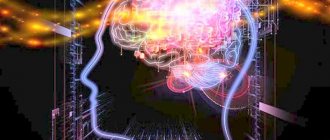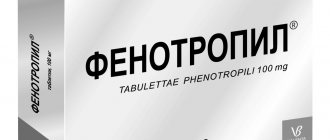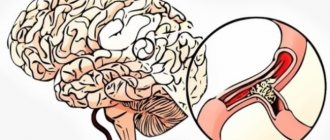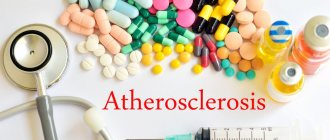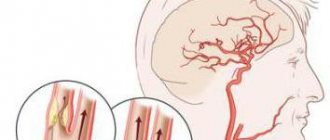Cerebral atherosclerosis is one of the types of atherosclerosis, in which the formation of atherosclerotic plaques in the vessels of the brain occurs, which leads to disturbances in cerebral blood supply.
The main cause of cerebral atherosclerosis is impaired cerebral circulation due to atherosclerotic plaques in the vessels
Cerebral atherosclerosis of cerebral vessels accounts for approximately 20% of the structure of general neurological pathology, as well as approximately 50% of all cases of cardiovascular diseases. Atherosclerotic lesions of cerebral vessels can be observed as early as 20–30 years of age, but pronounced clinical manifestations of the disease usually occur in patients over 50 years of age. Males are more susceptible to the disease, however, with age, cerebral atherosclerosis is registered in men and women with approximately the same frequency. This is due to the fact that after menopause, the level of estrogen in a woman’s body decreases, which inhibits the development of atherosclerotic vascular lesions.
The main clinical manifestations of the disease are caused by cerebral circulatory insufficiency, which gradually develops against the background of damage to cerebral vessels, leading to tissue ischemia. The formation of an atherosclerotic plaque occurs in several stages (from lipid stain to atherocalcinosis, or calcification). The formed plaque increases in size and gradually blocks the lumen of the affected blood vessel, contributing to its blockage with blood clots. Reducing the lumen of the blood vessel and, accordingly, deteriorating blood supply to the brain area leads to the development of hypoxia and nutrient deficiency. The progression of the pathological process causes degenerative changes and death of individual neurons. Part of the atherosclerotic plaque can break off and be carried by the bloodstream into smaller vessels, leading to sudden occlusion of the blood vessel. Impaired elasticity of the vascular wall at the site of atherosclerotic plaque formation, especially against the background of concomitant arterial hypertension, can lead to rupture of the vascular wall and the development of hemorrhagic complications.
Of all the cerebral vessels, the arteries of the pons, thalamus and subcortical nodes are more susceptible to atherosclerotic damage.
The development of severe complications of cerebral atherosclerosis can lead to patient disability and death.
Causes and risk factors
Cerebral atherosclerosis is classified as a polyetiological disease. First of all, the risk of developing cerebral atherosclerosis of cerebral vessels increases with age. Its occurrence at an earlier age usually occurs against the background of poor nutrition, metabolic disorders, excess weight, lack of physical activity, smoking, and alcohol abuse. In addition, arterial hypertension contributes to the development of pathology. Patients often experience a combination of cerebral atherosclerosis and high blood pressure, with both conditions aggravating each other.
The risk of developing cerebral atherosclerosis increases with an unhealthy lifestyle
Risk factors also include chronic infectious processes and intoxication of the body, which have an adverse effect on the vascular wall. An unfavorable psycho-emotional state, mental stress, as well as frequent stressful situations play a certain role. Genetic predisposition also matters. In clinical practice, family cases of the development of such a complication of cerebral atherosclerosis as stroke are often recorded.
Final word
Cerebral atherosclerosis is a serious and unpredictable disease, but you can reduce the risk of developing the disease or avoid it altogether by following preventive measures:
- First of all, if you have any suspicious symptom, do not be lazy to get examined! Damage to the blood vessels of the brain primarily harms your memory, intellect, consciousness - and in order to maintain a clear mind, it is worth playing it safe.
- Do not overuse animal fats. Of course, you shouldn’t completely exclude them from your diet (the body needs cholesterol), but fatty pork and beef should be replaced more often with veal, lamb and poultry, and when frying, butter should be replaced with vegetable oil. If you have a predisposition to atherosclerosis, you should also limit your consumption of eggs - no more than one per day.
- Stop smoking!
- If you have diabetes or other carbohydrate metabolism disorders, carefully monitor your blood sugar levels and do not allow them to rise.
- Move. Physical activity will help you keep your blood vessels toned.
Proper nutrition and following an appropriate diet are important.
Cerebrovascular atherosclerosis is a serious disease that affects intelligence and memory, and greatly impairs the quality of life. But it can also be prevented with reliable information.
Stages of the disease
In the clinical picture of cerebral atherosclerosis, three stages are distinguished:
- Development of functional vasomotor disorders, symptoms appear only occasionally, are unstable.
- Development of functional and morphological disorders, symptoms become more stable.
- Organic damage to blood vessels, symptoms are constantly present, complications often develop.
Development of cerebral atherosclerosis
Prevention
The following recommendations from doctors are used to prevent cerebral atherosclerosis:
- walks in the open air;
- rejection of bad habits;
- mandatory physical activity;
- avoidance of foods containing cholesterol - fatty dairy products, fatty meats, sugar, confectionery.
If all older people followed the recommendations presented, much fewer patients would die from strokes. In most cases, cerebral atherosclerosis is a consequence of improper eating and social behavior of citizens.
Symptoms
Clinical manifestations of cerebral atherosclerosis occur against the background of tissue ischemia, which develops when cerebral blood flow is blocked by an atherosclerotic plaque.
At the initial stage of the disease, manifestations of cerebral atherosclerosis are transient; they usually occur during physical and/or mental stress and disappear at rest. Patients complain of weakness, lethargy, fatigue, increased irritability, impaired concentration, and memory impairment. There are periodic disturbances in night sleep, insomnia, daytime drowsiness, dizziness (especially when changing body position from horizontal to vertical). The predominant symptom at this stage of the disease may be headache, which is combined with noise in the head, in the ears, or in one ear. In addition, patients may complain of numbness of the lower extremities, tingling in the face, a feeling of heat in the occipital region, blurred speech, decreased visual acuity, decreased hearing (up to its complete loss), and taste disturbances.
With cerebral atherosclerosis, patients complain of dizziness when changing body position
With further development of the pathology, intellectual and mental disorders worsen, and depression may develop. The patient develops anxiety, suspiciousness, and rapid mood swings. Noise in the head can be a constant concern. Also at this stage, gait and coordination of movements may be impaired, and tremors of the head and/or fingers may be noted. Efficiency is gradually lost.
With further progression of the disease, patients with cerebral atherosclerosis experience memory loss, apathy, loss of ability to navigate time and the environment, and loss of self-care skills.
An important sign that you should pay attention to in the presence of cerebral atherosclerosis is the development of a cerebral or hypertensive crisis. This condition is accompanied by intense headaches, weakness in one of the upper and/or lower extremities, speech disorders and visual impairment. Usually the crisis lasts no more than two days, after which the patient’s condition stabilizes. The persistence of symptoms for more than two days may indicate a complication of cerebral atherosclerosis by stroke.
Cerebral atherosclerosis of cerebral vessels accounts for approximately 20% of the structure of general neurological pathology, as well as approximately 50% of all cases of cardiovascular diseases.
Characteristics of the pathology
Cerebral atherosclerosis is a disease that affects the vessels in the head, which correlates with impaired brain function. Atherosclerosis of the vessels supplying blood to the brain has dangerous consequences - acute disruption of cerebral blood flow, which is associated with such a health and life-threatening condition as stroke. Atherosclerosis is characterized by a chronic course - plaques form on the walls of the vessels of the head, gradually calcify and increase in size, narrowing the lumen.
Cerebral atherosclerosis is a variable combination of pathological changes that occur in the intima (inner layer under the muscular layer) of arteries. As atherosclerotic changes progress, lipid and fibrous fractions, carbohydrates, blood components, and calcium compounds accumulate on the walls of blood vessels supplying the brain.
As a result, the arterial wall loses elasticity, becomes fragile, susceptible to rupture and mechanical damage. At the same time, atherosclerotic plaques, which increase in size, block the lumen in the vessels supplying the brain, preventing blood flow. Against the backdrop of deteriorating blood supply, the structure of the brain matter will gradually change, which leads to disruptions in the functioning of the entire body.
Diagnostics
To make a diagnosis of cerebral atherosclerosis, it is necessary to examine the patient by a neurologist. Diagnosis of the disease is based on medical history, clinical manifestations, as well as data from a number of additional examinations. Duplex scanning makes it possible to assess the condition of the extracranial arteries that supply the brain. This diagnostic method, in combination with ultrasound examination of the cranial arteries, allows one to obtain information about the localization of atherosclerotic lesions, the degree of narrowing of the blood vessel, as well as the nature of the atherosclerotic plaque. The condition of the blood vessels in the brain can be assessed by performing an angiographic study. Computed tomography is usually used in patients with cerebral atherosclerosis who have suffered a stroke to clarify the location of the lesion and select further treatment tactics. Magnetic resonance imaging is also used to assess the condition of cerebral vessels. The functional state of the brain can be assessed using electroencephalography. Pathological changes in the retinal vessels can be detected during ophthalmoscopy. In case of hearing impairment, the patient must be examined by an otorhinolaryngologist with audiometry performed. It may be necessary to conduct an immunological study, as well as a biochemical blood test to determine the level of cholesterol and lipoproteins (lipid profile).
MRI of cerebral vessels allows confirming the diagnosis of cerebral atherosclerosis
Diet
The disease can be successfully treated if the medication is accompanied by a special diet. It involves eliminating foods that contribute to the accumulation of cholesterol and consuming foods that cleanse the body. It is worth noting that this diet has merit. It not only improves health, but also promotes weight loss.
Here is a list of foods that you should not eat:
- egg yolks;
- mushrooms;
- pasta;
- rice;
- fatty dairy products;
- smoked and salted products;
- sweets made from butter and puff pastry;
- canned food;
- hot spices;
- chocolate;
- products with cream;
- some vegetables (radish, spinach, radish);
- sausages;
- all sauces, except natural vegetable ones;
- fat meat;
- offal;
- fried foods;
- fish caviar;
- fish, mushroom, meat and bean soups;
- some drinks (strong tea and coffee, cocoa).
But some foods should be consumed more often, as they help cleanse blood vessels:
- eggplant;
- wild strawberry;
- seaweed;
- cherry;
- watermelons;
- quince;
- grapefruits.
Try to eat cereals, vegetables and lean meats, boiled or baked. It is recommended to get a double boiler, because with its help you can cook food in such a way that the maximum beneficial properties are retained in the products.
You should not avoid soups either, as they improve the digestion process. An important condition is that they must be vegetarian.
If you want to treat yourself to something sweet, you can eat jelly, compote, berry juice and fruit.
Remember the important rule - nutrition should be balanced. Make a menu so that it contains enough vitamins and healthy elements. The more varied the diet, the better.
Treatment of cerebral atherosclerosis
Cerebral atherosclerosis is incurable, but with timely and adequate therapy it is possible to slow down its progression. When treating cerebral atherosclerosis, it is first necessary to eliminate the unfavorable factors that caused the development of the pathological process.
Conservative treatment of cerebral atherosclerosis is primarily aimed at improving cerebral circulation, as well as preventing thrombus formation.
If a patient with cerebral atherosclerosis has arterial hypertension, antihypertensive therapy is carefully selected. To correct the content of cholesterol and/or lipoproteins in the blood, lipid-lowering drugs are used. Taking nootropic drugs helps improve cognitive abilities. If necessary, patients with cerebral atherosclerosis are prescribed antiplatelet agents, vasodilators, and drugs that reduce the inflammatory process in blood vessels. In order to prevent the development of circulatory disorders, coronary lytic drugs are prescribed. In addition, in some cases, cascade filtration of blood plasma and cryoapheresis are used.
Atherosclerotic lesions of cerebral vessels can be observed as early as 20–30 years of age, but pronounced clinical manifestations of the disease usually occur in patients over 50 years of age.
Patients are advised to eat a diet that excludes foods high in cholesterol (margarine, fatty meats, eggs, sausages, canned fish, etc.); if they are overweight, the daily calorie intake is reduced.
For cerebral atherosclerosis, an anti-cholesterol diet is indicated
Repeated transient ischemic attacks, occlusion of the carotid artery with a decrease in its lumen by more than 70%, a history of minor stroke become indications for surgical treatment of cerebral atherosclerosis. The main surgical methods for this disease are the removal of the atherosclerotic plaque from the intimal area of the blood vessel (endarterectomy), as well as the creation of a vascular shunt that goes around the affected area of the artery.
Endarterectomy in the case of cerebral atherosclerosis is performed in a closed, i.e., endoscopic manner using balloons and stents. For this purpose, an endoscope with a stent is inserted into a wide blood vessel, then, under X-ray control, it moves to the site of blockage of the artery with atherosclerotic plaque, where a stent is installed, which increases the lumen of the blood vessel and, accordingly, restores blood flow. According to indications, prosthetics of the brachiocephalic trunk and the formation of extra-intracranial anastomosis can be performed.
Bypass surgery of cerebral vessels is an operation consisting of creating another blood flow path, bypassing a vessel affected by atherosclerosis. The shunt is created from the patient's vein or an artificial one is taken. It is sewn into the affected artery before and after the blockage site, without removing the damaged area.
How does atherosclerosis of cerebral vessels develop?
The causes of atherosclerosis are numerous factors:
- bad habits such as smoking and drinking alcohol;
- poor nutrition and excess weight;
- sedentary lifestyle;
- hereditary predisposition;
- long-term use of contraceptives.
What is cerebral atherosclerosis? A combination of several factors plays a role in the development of the disease.
Atherosclerosis of the cerebral arteries develops according to general principles. First, a small accumulation of lipid molecules forms in the endothelium in the form of spots and stripes. Then further accumulation of fat occurs and an atherosclerotic plaque is formed. Symptoms begin to appear when the plaque covers more than half of the lumen of the vessel.
Complications
The list of complications in pathologies such as cerebral atherosclerosis is very long. Brain cells quickly die when blood circulation changes, which entails many negative consequences. This includes the loss of important body functions. It is difficult to say how long it will take for death to occur with such a disease. But the most dangerous thing is a stroke. Also, a short path to death is atherosclerosis of the aorta, coronary cerebral arteries and aortic rupture. One of the most severe complications of atherosclerosis is aneurysms.
If the patient has concomitant diseases (for example, diabetes), then the likelihood of complications and death is very high. Patients also become worse due to the rapid development of atherosclerosis. All this leads to:
- Damage to the extremities (there may be ulcers and gangrene);
- Heart attack;
- Encephalopathy;
- Angiopathy and subsequent blindness;
- Nephropathy;
- Ischemia.
How dangerous is the disease?
Vascular plaques begin to form at a young age. If a person leads an unhealthy lifestyle, smokes, suffers from physical inactivity, eats fatty and fried foods, foods containing a high concentration of simple sugars, and does not control weight, this often leads to rapid blockages of the lumens of arteries and veins. In atherosclerotic cardiosclerosis, the coronaries, which feed the myocardium and remove toxic metabolic products from it, suffer more than other vessels. The pathological process also affects the cerebral arteries that supply the neurons of the cortex. Severance of the resulting plaques leads to acute ischemia of vital tissues of the body, which is often fatal.

